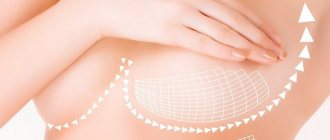Periareolar mastopexy is a surgical correction during which excess fat is eliminated and the shape of the breast is restored. This type of plastic surgery is used for slight breast sagging.
The mammary glands consist of glandular, fatty and connective tissues. They are located on the pectoral muscles. During lactation, the milk ducts produce and deliver milk to the nipple. Adipose tissue provides breast elasticity. However, often the ligaments supporting the gland become stretched and lose their elasticity.
Preparing for surgery
Before mastopexy surgery, a comprehensive examination is prescribed, the purpose of which is to assess the general health of the patient, identify possible contraindications and determine a number of criteria important for choosing the type of anesthesia. The list of events includes:
- laboratory tests (blood and urine tests);
- ECG;
- fluorography;
- Ultrasound of the mammary glands;
- Doppler ultrasound of the veins of the lower extremities.
According to indications, consultations with a mammologist, anesthesiologist, or therapist may be required. In addition, the patient is given recommendations for self-preparation (refusal to take medications that interfere with blood clotting, smoking and drinking alcohol, etc.).
Rehabilitation
After the operation, the patient is transferred to the recovery room, and after 1-1.5 hours - to a regular ward. As a rule, discharge occurs the next morning. The patient is given a memo detailing all the requirements for the recovery period. During rehabilitation, there are 4 mandatory examinations by a surgeon. You can return to your normal life 3-4 days after surgery; full recovery takes several weeks.
You can make an appointment for a consultation regarding periareolar mastopexy in Moscow, at the Bust Clinic breast augmentation center, by calling the numbers listed on the website or online.
Periareolar mastopexy is a breast lift technique in which an incision is made along the edge of the dark peripapillary area. This correction method allows you to restore your bust to an attractive and toned appearance with minimal damage.
There are a number of situations in which breast lift is indicated. They are associated with a sharp stretching of the skin on the chest as a result of weight loss or other factors.
- the appearance and excess skin on the chest after breastfeeding;
- loss of tone in the pectoral muscles after sudden weight loss;
- sagging breasts and loss of muscle tone as a result of age-related changes;
- the need to maintain a beautiful breast shape without the use of implants.
The operation will also help solve the problem of the nature of a flat chest and displacement of the nipple and areola beyond the inframammary line.
Like other surgical interventions.
Direct prohibitions on intervention are:
- pregnancy and breastfeeding;
- the presence of tumors in the breast, regardless of their nature;
- acute infectious diseases;
- diseases of the heart, blood vessels, endocrine system, liver, kidneys;
- obesity;
- neurological and mental disorders.
Preparation and performance of mastopexy
Breast lifting, regardless of the chosen method, requires preliminary preparation. It is important not only to change your lifestyle before surgery, but also to undergo a series of examinations. A month before mastopexy, it is recommended to completely give up alcoholic beverages and smoking, and stop taking medications that affect blood clotting.
Patients must undergo the following examinations:
- blood analysis;
- electrocardiogram;
- Analysis of urine;
- coagulogram;
- blood test for infections;
- fluorography;
- breast ultrasound.
Before mastopexy, a consultation with a surgeon is carried out. The required result is determined and the method of performing the procedure is selected. Breast correction itself takes place in several stages.
- Consultation with a specialist. Before mastopexy, the doctor conducts a control examination and draws lines on the chest along which the incision will be made.
- Anesthesia. For breast correction, general anesthesia is used.
- Breast incision and lift. Depending on the method chosen, incisions are made on the chest. Excess fat and skin tissue is removed. Absorbable sutures are placed on the inside of the wound. The upper part is stitched with nylon.
- Drainage. If there is a large outflow of blood or ichor, drainage can be installed. Removing excess fluid from the breast is necessary to prevent inflammation.
The lift does not take more than 3 hours. In most cases, the procedure lasts from 1 to 2 hours.
Operation technology
During the procedure, the nipple is not separated from the skin; it is moved to a higher position, like a lifted breast. Excess sagging breast skin is also removed. There are several ways to perform a mastopexy. The choice of a specific technique depends on the degree of ptosis (drooping) of the mammary glands:
- Half-moon cut.
- Circular mastopexy.
- T-shaped cut.
- Vertical short seam technique.
Another important point is that mastopexy does not restore the structure of the glands, but lifts them and corrects their shape. One of the consequences of the procedure may be a reduction in bust size. Therefore, the operation is often combined with the installation of silicone implants to increase the size of the glands.
Preparation and collection of analyzes
To get good results with minimal risk to health, you need to take preparation seriously. The first stage is consultation with specialists. Before the procedure, a woman will need to consult the following doctors:
Specialist
Medical actions
Methods for performing mastopexy
There are several techniques for performing mastopexy. Preference for specific methods is given depending on the desired result and the individual characteristics of the patient.
- Vertical method. Suitable for moderate ptosis. The incision is made along the areola and goes to the inframammary fold. This method removes excess glandular tissue, as well as upward movement of the mammary gland and nipple.
- T-shaped method. Used for pronounced sagging and stretching of the breast skin. The incision is carried out similarly to the vertical method. Additionally, an incision is made along the inframammary fold. The method is one of the most traumatic, but gives the best result.
- Periareolar lift. Necessary for minimal stretching. A circular lift involves making an incision around the circle of the areola. This allows you to remove excess skin tissue without damaging the gland. The areolar mastopexy method involves securing the breast to the muscle using sutures. Circular mastopexy is one of the least traumatic methods of breast correction. It is suitable for small to medium sized breasts.
Depending on the chosen method, the specialist imposes restrictions and makes recommendations for the rehabilitation period. The accumulation of exudate in the wound can be avoided by applying drainage tubes. Self-absorbable threads are used for internal seams, and non-absorbable threads for external seams. They must be removed after 7-14 days.
The rehabilitation period after mastopexy takes from 1 to 2 months. However, the specialist’s recommendations for the first weeks and subsequent period will differ. The patient’s behavior in the first weeks after the intervention has a great influence on maintaining the result.
The first day is spent in a hospital setting. This is necessary to monitor the body's reaction to the operation. Constant monitoring eliminates the occurrence of inflammation and allergic reactions.
In the first hours after the intervention, patients experience weakness, nausea, pain, and swelling of the breast tissue.
- do not make sudden sweeping movements;
- Do not take a position associated with tension in the seam area.
- take anesthetics;
- prevent water from getting into the seams;
- treat wounds with antiseptic compounds;
- avoid mechanical impact;
- sleep on your back;
- eliminate hard work.
A week after mastopexy, you should see a doctor to check the condition of the sutures and remove them. With an active healing process, a number of restrictions are removed, and the patient can return to her normal lifestyle.
For 3 months after mastopexy, you should adhere to a number of rules:
- avoid sports and increased stress;
- use compression garments;
- exclude visiting the steam room, solarium;
- avoid prolonged exposure to direct sunlight;
- strengthen the immune system.
Final healing occurs only 3-4 months after the correction.
During this period, the swelling from the tissues completely disappears and it becomes possible to evaluate the result.
Cons of removing skin around the areola
Despite all the advantages of the method, it also has a number of significant disadvantages. The main thing is that the operation can be performed only with slight stretching of the breast skin. In addition, there are additional disadvantages:
- Not suitable for “thick-skinned” patients, that is, women with elastic and dense skin. Although their scarring goes well, under the influence of gravity the scar stretches in width and turns out to be rough.
- Tomato syndrome or tomato effect - the operation leads to a reduction in the limb of the breast, it becomes flattened like a tomato. By removing the middle section and pulling the upper cone towards the flatter lower part of the chest, we flatten the upper, sharper part.
- When using this lifting method in conjunction with endoprosthetics, we enhance the stretching effect in the scar area (the entire weight of the mammary gland and implant, under the influence of gravity, stretches the scar).
- For the same reason, this method is undesirable for patients with a large volume of glandular tissue.
This method is easy to perform and therefore is popular with surgeons. It attracts patients with the promise of almost invisible post-operative scars. But before choosing it, you need to weigh the pros and cons, assessing your particular situation.
Possible complications after breast correction
Mastopexy is an intervention in the functioning of the body.
Violating the sequence of the procedure, using unsterile instruments or contacting an illiterate specialist can lead to complications.
- Bleeding. The most common complication. Associated with vascular fragility. It occurs as a result of blood leaking out of a damaged vessel and its accumulation in the incision area. To eliminate the complication, drainage is installed on the postoperative suture, and a clip is applied to the vessel.
- Inflammation. Occurs as a result of infection of a chest wound due to the use of unsterile instruments, a weak immune system, or the ineffectiveness of antibiotics. Characterized by pain and hyperthermia. The skin over the inflammation turns red.
- Decreased breast sensitivity. Occurs in half of the situations. If you follow the rules of the rehabilitation period, it goes away on its own a few months after the intervention.
- Slow recovery. Slow tissue fusion is rare. The complication is typical for elderly patients, smokers, and those who are overweight. The disorder may be accompanied by necrosis, disruption of the blood supply to the tissues of the mammary gland and nipple.
- Postoperative scars. Circulatory mastopexy affects only the areola, the scar remains along the edge of its dark area. Thus, it becomes less noticeable than during. The use of regenerating creams during the rehabilitation period can reduce the risk of scars.
- Formation of folds. Periareolar breast lift, if the intervention is carried out carelessly, leads to the formation of skin folds in the peripapillary area. It is difficult to get rid of them later.
The choice of a specialized clinic and a competent doctor allows you to reduce the negative consequences of the intervention. Toned and beautiful breasts are possible at any age and for every woman.
When problems arise with the breasts, such as loss of firmness, tone, and elasticity, women often turn to a plastic surgeon. Depending on the degree of development of the defects, the doctor prescribes different types of breast lift. Periareolar mastopexy is an effective way not only to restore an attractive shape to the mammary glands, but also to correct asymmetry or malposition of the nipples or areola.
Vertical section
It is also a very gentle technique, implying a small volume of excised tissue. But unlike periareolar, it allows you to cope with higher degree ptosis. The sensitivity of the breasts and nipples is not impaired, the ability to breastfeed is preserved as with other methods of access. The disadvantages of the method include its ineffectiveness in cases of significant prolapse of the glands.
Some women are concerned about the visibility of the vertical scar that runs from the bottom edge of the areola to the fold under the breast. But a qualified surgeon always performs suturing in such a way that traces of the intervention are as less noticeable as possible. Much also depends on the patient herself: how carefully she paid attention to the doctor’s recommendations during the recovery period. If all instructions are followed strictly, the scars will be completely invisible.
When is areolar mastopexy necessary?
Surgical correction using the areolar method is carried out using incisions around the circumference of the pigmented area of the areola. For minor problems, the incision is made only along the upper line of pigmentation, for larger ones - along the entire perimeter.
Indications for areolar lifting:
- Decreased breast elasticity and tone;
- Abundance of skin tissue in the areola area;
- Asymmetry or deformation of the nipples;
- Change in the shape of the glands in the areolar zone.
Contraindications include diseases of the endocrine, circulatory, cardiovascular, and nervous systems, as well as cancer, acute and chronic infections. In addition, the surgeon will not allow surgery on a pregnant woman or nursing mother.
Contraindications to areolar mastopexy
You may ask whether all women can return their breasts to girlish shapes using this procedure? Unfortunately no. Mastopexy, even performed using the most gentle method, is a serious operation that is traumatic for breast tissue. And it has the same contraindications as any cosmetic surgery:
- bleeding disorders;
- mental disorders;
- severe internal illnesses;
- decompensated metabolic disorders.
There are also time restrictions:
- age (mastopexy is not performed for girls under 18 years of age);
- multiple cysts in the chest area (after a course of treatment, surgery can be considered again);
- taking anticoagulants and NSAIDs during the period for which surgery is planned;
- exacerbation of chronic diseases;
- acute period of infections.
That's all we wanted to tell you about this operation. If you still have questions, we are happy to answer them by preparing the following review on the topic that interests you. Read our new articles and share information with friends using social networks.
Periareolar mastopexy as a type of breast lift
Periareolar mastopexy is suitable for women with moderate to moderate ptosis. If the patient has excess skin or fat tissue, the doctor will suggest another option, such as a T-lift. It is also not recommended to use the periareolar method for smokers or obese women.
Operation with periareolar incision:
- Before administering anesthesia, the doctor makes marks on the surface of the chest along which the incisions will be made;
- During plastic surgery, the specialist cuts the skin along the marked lines - around the nipple along the entire or partial line of the areola;
- The surgeon separates the mammary gland from the muscle and fat layer, removes excess subcutaneous tissue and external tissue.
Upon completion of the correction, the edges of the skin are connected and stitched with self-absorbing sutures. A sterile bandage is applied on top, which must be changed daily for 1-2 weeks.
Contraindications to the procedure
This type of bust enhancement is not suitable:
- ladies with significant excess skin and loss of elasticity;
- obese women;
- patients suffering from tobacco addiction;
- and very old people.
The operation is not performed on healthy women:
- During the period of planning conception.
- Pregnant and lactating.
The procedure is strictly not recommended for patients:
- with serious mental disorders;
- exacerbation of chronic ailments;
- serious pathologies of the heart and blood vessels;
- during the acute period of an infectious disease;
- with metabolic diseases;
- tendency to form keloid scars;
- oncopathology;
- scars and fibrous changes in the mammary glands.
Before the operation, a woman needs to undergo an examination, take tests, and consult with a mammologist.
Periareolar mastopexy: before and after the procedure
A favorable outcome of plastic surgery and the absence of complications is a consequence of the correct choice of the operating doctor. In Moscow, you can contact Dr. Rano Azimova, Candidate of Medical Sciences and an expert in aesthetic surgery. Her high professionalism and extensive experience ensure effective results after mastopexy:
- Restoration of the elastic shape and structure of the breast;
- Getting rid of loose areas of supraglandular skin;
- Smooth redistribution of soft tissues;
- Confidence in yourself and your figure.
You can choose the most reliable and effective way to tighten your breasts during a free consultation. To make an appointment, call the number on the website.
In plastic breast correction, mastopexy ranks second in popularity (the first position is “classic” size increase). And this is not surprising - with the help of professionals, any woman can correct the shape of her breasts, become attractive and seductive, despite her age, having children and breastfeeding.
Prices for all types of mastopexy
| Type of transaction | Cost of the operation |
| Breast lift with enlargement 2 cat. complexity (with a vertical scar) (without the cost of implants) | RUB 365,550 |
| Breast lift with 3rd grade enlargement. complexity (with a T-shaped scar) (without the cost of implants) | RUB 385,550 |
| Breast lift with increase 1 category. complexity (periareolar) (without cost of implants) | RUB 335,550 |
| Breast lift | |
| periareolar | 165,000 rub. |
| with vertical scar | 195,000 rub. |
| with T-scar (difficulty category 1) | 217,000 rub. |
| with T-scar (difficulty category 2) | RUB 249,000 |
| with T-scar (3 category of complexity, with reduction of one breast) | 280,000 rub. |
| Breast lift and correction of breast asymmetry | |
| 1 cat. difficulty (with vertical scar) | 228,000 rub. |
| 2 cat. complexity (with a T-shaped scar) | RUB 257,000 |
| Single breast lift | |
| 1 cat. complexity (periareolar) | 123,000 rub. |
| 2 cat. difficulty (with vertical scar) | 148,000 rub. |
| 3 cat. complexity (with a T-shaped scar) | 165,000 rub. |
The “before” and “after” photos of a breast lift demonstrate the impeccable results of aesthetic surgeries.
Mastopexy can be either an independent procedure (for sagging breasts) or a complex solution - performed simultaneously with augmentation with implants or your own fat tissue. In addition to eliminating ptosis, plastic surgery is indicated for asymmetry of the breast and nipple-alveolar complex.
Progress of the operation
First, markings are made on the operated area. The patient is then sent to an anesthesiologist. The procedure is performed under anesthesia (that is, using general anesthesia). The surgeon then makes two incisions, removing a flap of skin between them. The surgeon then pulls the skin outside the second incision toward the nipple and sutures it.
Internal sutures are placed using absorbable sutures, external sutures are made using non-absorbable synthetic suture material (usually nylon). The seams are fixed with a special plaster. You can evaluate your bust before and after surgery before removing the stitches.
If you doubt the effectiveness, look at the photos that all plastic surgeons offer for viewing as an advertisement for their work. With this we say goodbye to you until the next articles. Read our feature stories and share interesting information with friends via social networks.
Plastic breast lift - correction of ptosis
Excess skin and soft tissue are excised and the breast is subsequently fixed in an elevated position.
Lifting during complex mammoplasty
The tactic involves installing implants (to increase breast size) with simultaneous surgical removal of excess tissue.
Features of correction
Plastic breast lift involves creating a long incision for surgical access (except for periareolar correction). However, due to the unique techniques used by doctors at the DOCTORPLASTIK clinic, postoperative scars are barely noticeable, cosmetically aesthetic and do not cause discomfort.
Mastopexy techniques
Periareolar breast lift
To correct minor ptosis (especially if a breast lift with additional augmentation is required), a periareolar breast lift is performed. In this case, the incision will pass around the areola, so the postoperative scar will be practically invisible. Increasing breast volume with implants will further lift the breasts and enhance the effect, so the result will be as natural and attractive as possible.
Breast lift with vertical incision
With more severe ptosis of the mammary glands, a large amount of excess skin will need to be removed. In this case, for an attractive result, it is necessary to make an additional vertical cut. Many patients are concerned about the postoperative stitches that it will leave.
Anchor breast lift
This method of mastopexy helps improve the shape of the breast in the most difficult cases. With it, the incisions resemble an anchor in their shape (around the areola, vertical, in the inframammary fold). With this approach, the postoperative scar is no more noticeable than the marks after a vertical breast lift.
Indications
Mastopexy is carried out exclusively on the woman’s initiative to give more perfect contours to the figure and eliminate aesthetic defects, including:
- noticeable changes in shape;
- asymmetry;
- stretched skin;
- loss of elasticity and sagging skin;
- hanging nipples below the mammary fold;
- elongated areolas.
Contraindications
Breast lift is a simple plastic surgery procedure. Medical contraindications:
- pregnancy;
- cardiovascular diseases;
- disruption of hemostasis processes;
- diseases of internal organs;
- diabetes;
- oncopathology;
- exacerbation of inflammatory, infectious, chronic diseases.
Duration of correction, anesthesia
Depending on the degree of tissue prolapse and the chosen technique, surgical intervention lasts from 1 to 2 hours. A distinctive feature of a plastic breast lift at the DOCTORPLASTIC clinic in Moscow is safety, minimal trauma and an impeccable aesthetic result. The highest level of skill and experience of our surgeons also ensure a quick recovery - without postoperative complications or long and painful rehabilitation.
Any type of mastopexy is performed under general anesthesia with modern painkillers.
Rehabilitation
The patient can return home no earlier than 6 hours after breast lift surgery. But the comfortable rooms of our inpatient department contribute to maximum relaxation and recovery in the postoperative period, and therefore most women prefer to stay in the clinic for a day under the supervision of our clinic’s medical staff.
Painful sensations in the first days can be controlled with medication. You can resume professional activities no earlier than after 1–3 weeks. During the first month you must:
- wear compression garments;
- limit physical activity;
- Avoid sun exposure, swimming pools, baths or saunas.
Possible complications
- Slight increase in temperature, pain, swelling, hematomas (pass within 3-4 days).
- Changes in sensitivity of the nipple (recovered within 1–2 months) or skin in the area of mastopexy.
- Asymmetry (with uneven subsidence of swelling).
- Hypertrophic scars (due to individual predisposition).
Strict adherence to medical recommendations and a course of rehabilitation procedures will help reduce the manifestations of postoperative symptoms.
100% result
Mastopexy at the DOCTORPLASTIC clinic is performed by the best aesthetic surgeons in Moscow, the price of the operations is the optimal balance of impeccable quality of correction, high level of medical service at all stages (from diagnosis to rehabilitation). Need confirmation? Read the story of Rita Kuzina's breast lift (the heroine of the TV project Dom-2), check out the photo gallery of the results of the operations.
Not only residents of Moscow can undergo plastic breast lift surgery and receive advice. Our clinic was visited by many patients from Voronezh, Volgograd, Rostov-on-Don, Samara, Krasnoyarsk, Novosibirsk, Yekaterinburg, Kazan, Nizhny Novgorod, Omsk, Perm, Ufa, Chelyabinsk and other cities of Russia.
Call and schedule an online consultation to create the perfect breast shape. The price of mastopexy in Moscow is from 123,000 rubles. up to 280,000 rub. The cost depends on the category of complexity and type of cut.
Our advantages
After childbirth or with age, breasts lose their shape and begin to sag. Mild forms of ptosis can be eliminated almost bloodlessly - with the help of a periareolar lift. The same procedure allows you to reduce the areola of the nipples if they have stretched too much. Next we will tell you in what cases this operation is indicated and what are its advantages over other types of lifting.
What is periareolar mastopexy
This type of lift is used when you need to raise your nipples to a more natural level and slightly lift your breasts up. Periareolar mastopexy is also used to remove a hernia of the mammary glands. If there is excess skin or ptosis is too pronounced, this procedure is not suitable because the load on the sutures is too high. Lifting can be combined with breast augmentation surgery; in this case, implants are inserted through incisions near the nipples.
There are two types of periareolar lift:
- concentric;
- crescent.
With a concentric breast lift, two incisions are made around the areola - one at the very border, and the second a little further. The excess skin between the two incisions is removed, and then the edges of the tissue are sutured to the borders of the nipple. As a result, the breasts tighten and become denser, but this procedure does not remove a large amount of skin.
If you need to raise the nipples higher than 5 cm, this can lead to gathering of the skin around them and other unpleasant consequences. Concentric lifting does not interfere with future breastfeeding and has virtually no effect on skin sensitivity.
With a crescent breast lift, the area of tissue that can be removed is minimal. This operation allows you to raise the nipple by 1-2 cm and is well suited for patients with small breasts. In this case, not two concentric incisions are made, but one semicircular one at the border of the areola.
The length of the incisions and the width of the skin removed depend on the degree of ptosis. This type of mastopexy can be used to correct nipple asymmetry and areola shape. Given the speed of recovery and the minimum of incisions, this procedure can be performed multiple times as needed.
Periareolar mastopexy: features of the method
Periareolar mastopexy is considered a gentle technique with a minimum number of postoperative sutures. With its help, the breasts acquire a natural shape, beauty and elasticity. However, this method is indicated only for a certain category of patients. Due to the fact that the incisions are made around the circumference of the areola, it is not suitable for women with significant breast prolapse, since in this case the stress on the sutures will become too intense. The shape of the breast is also important, because after excision of excess skin, the bust becomes neater and flatter. Therefore, this method is recommended for owners of an elongated, cone-shaped hair.
Preparatory stage
Before surgery, periareolar mastopexy is examined and consulted with a surgeon. The specialist assesses the degree of ptosis, the condition of the skin and offers the most suitable option for improving the figure. He talks about the features of the periareolar mastopexy method, the limitations of the rehabilitation period, possible risks and complications. Next, a referral is issued for the following diagnostic examinations:
- clinical analysis of urine and blood;
- determination of blood groups and Rh factor;
- analysis for hepatitis, AIDS, syphilis;
- mammography;
- fluorography;
- ECG.
In addition, if you have chronic diseases, you should consult with specialized specialists, since periareolar mastopexy is considered a full-fledged surgical intervention on the human body. Contraindications to the procedure are:
- age under 18 years;
- less than 1 year after the end of lactation;
- blood diseases;
- disruption of the endocrine, cardiovascular and respiratory systems;
- skin and infectious diseases;
- detection of lumps in the mammary glands.
If the examination results show that periareolar mastopexy is possible, it is necessary to stop smoking, drinking any alcoholic beverages, as well as medications that impair blood clotting. In the evening before plastic surgery, you are allowed to have a light dinner, and afterward you cannot eat or drink water.
Execution technique
Periareolar mastopexy begins with marking in a standing position with a straight back and arms down. After the surgeon makes sure that the lines are absolutely symmetrical, the woman is given general anesthesia. The choice of this particular type of anesthesia is determined by the fact that the operation lasts more than two hours and it is easier for a specialist to work with a completely relaxed body.
Periareolar mastopexy involves two incisions. The first is along the areolar circle, and the second is along a circular line at some distance from the first. A strip of skin and glandular tissue between the incisions is removed in such a way that the blood vessels supplying the nipple-areolar complex are not affected. Next, the skin is pulled to the nipples and stitched with a cosmetic suture using self-absorbing threads. The renewed breast is fixed using strips and a sterile bandage.
Recovery
Periareolar mastopexy requires the first few days in the clinic under the supervision of a doctor, where courses of antibacterial and painkillers are prescribed.
If after three days the woman feels satisfactory, she is discharged home, having previously been consulted about all the features of the rehabilitation period. Periareolar mastopexy differs from other techniques in that all manipulations are performed in the nipple area. Therefore, this method is dangerous because it reduces their sensitivity. To prevent complications, the surgeon tries not to touch the fourth intercostal nerve during the operation, the branches of which entangle the mammary glands. If this is successful, then sensitivity is restored on days 10–12, when all hematomas and swelling subside. Otherwise, you have to resort to additional measures. These include taking medications with a pronounced stimulating effect on nerve fibers, acupuncture, and electrotherapy.
Recovery after periareolar mastopexy surgery includes caring for sutures, maintaining sexual rest, limiting physical activity, and wearing compression garments. For six months, it is prohibited to visit the beach, solarium, bathhouse, sauna, as well as long trips and intense sports.
Main objectives of the operation
The main reasons for mastopexy are aesthetic. The circular lift can be used for:
- raising the nipples to the desired level;
- removing excess skin;
- eliminating breast asymmetry;
- light lift;
- reducing the size of the areola.
To make the effect after surgery more effective, the surgeon must examine the breast and measure all the necessary parameters. To determine where the nipple will be, the doctor must determine at what level the skin fold under the breast is, and then make preliminary markings. The lines will help the surgeon perform the operation faster, since he will not have to guess by eye where and how long to make the incisions.
Types of access
To understand how a breast lift is performed, you can familiarize yourself with existing surgical techniques. Mastopexy is performed using one of three methods:
- periareolar,
- vertical,
- T-shaped.
The techniques differ in the way of cutting. A periareolar incision is made around the circle of the nipple areola, a vertical one - around the circle of the areola and vertically from its lower edge to the fold under the breast, a T-shaped (anchor) - around the circle of the areola, vertically to the fold and horizontally in the fold itself.
The choice of method is made by the surgeon depending on the patient’s situation and the degree of ptosis. The periareolar method is suitable if there is slight ptosis or small breast size. Vertical is indicated for patients with more severe ptosis. An anchor incision is performed in cases of significant prolapse and very large bust size.
Advantages of periareolar mastopexy
The main advantages of a periareolar breast lift are:
- very small and almost invisible scars;
- compatibility with breast augmentation or reduction surgery;
- minimum duration of the procedure (no more than 2 hours);
- maintaining nipple sensitivity;
- fast rehabilitation;
- possibility of recovery at home (the period of inpatient observation is only 1 day).
Disadvantages include possible side effects such as flattening of the breast shape if the skin is too tight. If during the operation the surgeon inadvertently touches the milk ducts, lactation will be disrupted in the future. In some cases, you may be allergic to painkillers and antiseptic medications used during surgery and recovery.
Indications and contraindications
The operation is prescribed primarily in cases where:
Despite the relative simplicity and speed of recovery, periareolar mastopexy is not suitable for all women. Among the main contraindications are:
- Lactation. If less than a year has passed since breastfeeding or the birth of a child is planned in the near future.
- Blood diseases.
- Cardiovascular diseases.
- Chronic diseases in the acute stage.
- Lung diseases.
- Diabetes mellitus in a severe stage.
- The presence of infections in the body.
- Tuberculosis.
- Masses in the mammary glands, too many cysts or urgent need for treatment.
Even if there are no obvious contraindications, you should consult a doctor before surgery to make sure there are none.
Who is not allowed to have a breast lift?
Contraindications to the operation are:
- The patient is a minor.
- The presence of chronic viral infections.
- Problems with blood clotting.
- Mastopathy.
- The presence of a tumor in the body.
- Disturbances in the functioning of the endocrine system.
- Presence of contraindications to pain relief.
- Problems with blood pressure.
- Problems with the nervous system.
- Diabetes.
- ARVI.
- Exacerbation of acute somatic ailments.
- Hormonal imbalances.
- Reduced immunity.
Temporary contraindications to mastopexy include:
- pregnancy;
- lactation;
- problems with excess weight;
- progressive weight loss;
- the operation will not bring the patient the desired result.
Areolar mastopexy is performed only at the beginning stage of bust sagging. At later stages, the procedure is ineffective, since noticeable unaesthetic seams may remain on the body, and the breast lift will not be very noticeable.
How to prepare for surgery
In order for surgery to be successful and without risks, you need to properly prepare for it.
First of all, you need to undergo medical examinations to make sure there are no contraindications. The second part of the preparation consists of some restrictions on food and habits that need to be introduced a few days before the procedure.
Medical examination
First of all, you will need to do a number of tests:
You will also need to know exactly your blood type and Rh factor. In addition to tests, you need:
- mammography;
- fluorography.
You will need to visit a GP to check your general health. Consultations with a surgeon and mammologist are also required. If the patient has vascular diseases or chronic diseases, it is necessary to undergo examination by specialized doctors. You need to do all the tests and see the doctors 14 days before the intervention, this is how long the results are valid.
Restrictions before surgery
Some time before the operation you will have to give up a number of habits and change your diet:
How is the operation performed?
Since on average the procedure lasts 1.5-2 hours (sometimes longer - up to 3), general anesthesia is most often used. The operation itself is simple:
- Based on the markings, the surgeon makes incisions around the nipple.
- The skin ring is removed.
- The nipple and tissue edges are sewn together.
- The seams are treated with an antiseptic.
- A surgical plaster is placed on top of the sutures to prevent the edges from coming apart due to tension during the first time after surgery.
Self-absorbable threads are used to stitch tissue inside the wound, and the external seam is made of nylon. In some cases, a special tube is inserted into the wound, through which excess fluid drains.
Recovery time
The first day the patient is in the hospital under the supervision of doctors. Vomiting and nausea after recovering from anesthesia are a normal reaction of the body to the surgery experienced. Once the effect of the analgesics wears off, the patient may experience chest pain and swelling will become more noticeable. To reduce the intensity of these symptoms to a minimum, in the postoperative period you need to:
- wear special underwear;
- try not to raise your hands;
- do not make sudden movements;
- stick to positions that place the least amount of stress on the seams.
If no complications arise on the first day, the patient is discharged the next day after surgery. At home, it is important to follow all doctor’s instructions so that the stitches heal faster and there are no complications.
The surgeon will explain what you need to do at home after surgery. The list of standard recommendations includes the following tips:
Scars will be fully formed after 4 months. After the same period, the swelling will completely subside, and only then can the results of the procedure be finally assessed.
Possible complications
Most complications occur due to improper breast care after surgery. Less commonly, some problems arise due to surgeon error. In any case, to minimize risks, you need to choose only proven plastic surgery clinics and experienced doctors.
Bleeding
In case of internal bleeding, the cavities where blood and interstitial fluid accumulate are drained. If there is too much blood, the surgeon needs to remove the stitches to find the damaged vessel and stitch it up. If this is not possible, special clamps are used to stop the bleeding.
Inflammation
An inflammatory process with severe pain, redness and pus can develop due to:
With severe inflammation, in addition to pain, there is an increase in body temperature, nausea and dizziness are possible. Under no circumstances should this process be left to chance; you should immediately consult a doctor.
Loss or decrease in sensation
Loss of sensation, complete or partial, is a common effect after breast surgery. If everything is in order, sensitivity of the nipples and the skin around them will return naturally in a few months.
Impaired healing
Long healing time after surgery is relatively rare. This disorder usually occurs in older people, obese people and smokers. The degree of severity can vary - from longer healing to tissue necrosis due to impaired blood supply.
Scars
Despite the fact that during plastic surgery they try to make the incisions as carefully as possible, there is still a risk of unsightly scars.
With circular mastopexy, the scar is not as noticeable as with other lifting methods, since it runs along the edge of the areola, but it can still cause aesthetic discomfort.
Formation of skin clusters
If too much excess skin is removed during surgery, it will be noticeable when stitched. The edges of the skin sewn to the nipple will be uneven and lumpy. Correcting this defect will be extremely difficult.










